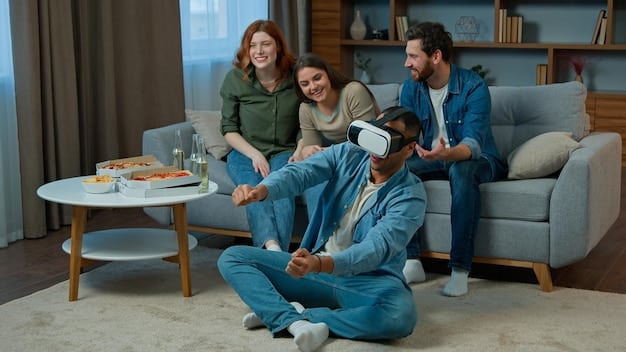Interactive Reality TV: The Future of Virtual Entertainment

Reality TV’s New Frontier: Exploring the Rise of Interactive and Virtual Reality Shows reveals how technology reshapes viewer engagement, offering immersive experiences and blurring lines between reality and virtual worlds in television entertainment.
The evolution of reality TV is entering a revolutionary phase, with interactive and virtual reality (VR) experiences poised to redefine viewer engagement. Reality TV’s New Frontier: Exploring the Rise of Interactive and Virtual Reality Shows is not merely a trend; it’s a paradigm shift that promises deeper immersion, personalized narratives, and unprecedented control for audiences.
The Dawn of Interactive Reality TV
Interactive reality TV represents a significant departure from traditional formats. Instead of passively observing contestants, viewers now have the power to influence outcomes, shape storylines, and even participate directly in the show’s events. This increased level of engagement fosters a stronger connection between audiences and the programs they watch.
What Defines Interactive Reality TV?
Interactive reality TV encompasses a range of formats that allow viewers to actively participate in the show. This can include voting on challenges, influencing contestant decisions, or even appearing on the show themselves through virtual means. The core principle is to empower viewers and give them a stake in the unfolding drama.
Examples of Early Interactive Formats
While the concept of interactive reality TV is relatively new, early examples have demonstrated its potential. Shows like “American Idol” paved the way by allowing viewers to vote for their favorite contestants. Today, more sophisticated platforms are emerging that offer even greater levels of interactivity.
- Voting systems: Allowing viewers to decide the fate of contestants.
- Social media integration: Using platforms like Twitter and Facebook to gather audience input.
- Live polls and quizzes: Engaging viewers in real-time decision making.
The rise of interactive reality TV signals a move towards more participatory entertainment experiences. As technology continues to evolve, we can expect to see even more innovative formats emerge that blur the lines between viewer and participant.
Virtual Reality Enters the Reality TV Arena
Virtual reality (VR) is poised to take reality TV to new heights by offering viewers immersive experiences that were previously unimaginable. By strapping on a VR headset, audiences can step into the world of the show and interact with contestants in a virtual environment. This level of immersion creates a powerful sense of presence and engagement.

The Potential of VR in Reality TV
VR offers a unique opportunity to create truly immersive reality TV experiences. Viewers can explore the show’s setting, interact with contestants, and even participate in challenges from the comfort of their own homes. This level of engagement can lead to deeper emotional connections with the show and its participants.
Challenges and Opportunities
While VR holds immense potential, it also presents some challenges for reality TV producers. Creating high-quality VR experiences requires significant investment in technology and expertise. Additionally, producers need to find ways to seamlessly integrate VR into the show’s narrative without alienating viewers who don’t have access to VR equipment.
- Technological limitations: Ensuring smooth and reliable VR experiences for all viewers.
- Accessibility: Making VR content available to a wide audience.
- Content creation: Developing compelling VR narratives that keep viewers engaged.
Despite these challenges, the opportunities for VR in reality TV are vast. As technology becomes more affordable and accessible, we can expect to see more VR-based reality shows emerge that push the boundaries of entertainment.
The Impact on Viewer Engagement
Interactive and VR technologies have a profound impact on viewer engagement in reality TV. By giving viewers more control and immersing them in the show’s world, these technologies create a deeper emotional connection and foster a sense of community. This increased engagement can lead to higher viewership and greater loyalty among fans.
From Passive Observer to Active Participant
The shift from passive observer to active participant is a key aspect of interactive and VR reality TV. Viewers are no longer simply watching the show unfold; they are actively involved in shaping its outcome. This level of participation creates a more rewarding and engaging viewing experience.
Consider the difference between watching a cooking competition and actually voting for your favorite dish or even virtually assisting a contestant in the kitchen. The latter experience is far more immersive and emotionally engaging.
Building a Sense of Community
Interactive and VR technologies can also help build a sense of community among viewers. By interacting with each other in virtual environments or participating in online discussions, fans can connect over their shared love of the show. This sense of community can enhance the overall viewing experience and create a stronger bond between viewers and the show.

The rise of interactive and VR reality TV represents a significant shift in the relationship between viewers and the programs they watch. By empowering viewers and fostering a sense of community, these technologies are transforming the landscape of entertainment.
Ethical Considerations in Interactive Reality TV
As interactive and VR reality TV become more prevalent, it’s important to consider the ethical implications of these technologies. Giving viewers more control over the show’s outcome raises questions about fairness, manipulation, and the potential for abuse. Producers need to establish clear guidelines and safeguards to ensure that these technologies are used responsibly.
The Potential for Manipulation
One of the key ethical concerns is the potential for manipulation. Producers could use interactive or VR elements to subtly influence viewer opinions or create artificial drama. This could lead to unfair outcomes for contestants and a distorted representation of reality.
Privacy Concerns
Another ethical consideration is privacy. Interactive and VR reality TV often involves collecting data about viewer behavior and preferences. Producers need to be transparent about how this data is being used and ensure that viewers have control over their personal information.
- Transparency: Being upfront about how interactive and VR elements are used in the show.
- Fairness: Ensuring that interactive elements don’t unfairly influence the outcome of the show.
- Privacy: Protecting viewer data and respecting their privacy rights.
Addressing these ethical concerns is crucial for ensuring the long-term sustainability of interactive and VR reality TV. By prioritizing fairness, transparency, and privacy, producers can build trust with viewers and create a more positive viewing experience.
The Future Landscape of Reality TV
The future of reality TV is undoubtedly intertwined with interactive and virtual reality technologies. As these technologies continue to evolve, we can expect to see even more innovative and immersive formats emerge that push the boundaries of entertainment. The key will be to find a balance between technological innovation and compelling storytelling.
Predictions for the Next Decade
In the next decade, we can expect to see several key trends emerge in interactive and VR reality TV. These include:
- Increased personalization: Shows that adapt to individual viewer preferences and interests.
- More immersive VR experiences: Higher-quality graphics and more seamless integration of VR technology.
- Greater viewer control: More opportunities for viewers to influence the show’s outcome.
The Blurring Lines Between Reality and Virtual Worlds
One of the most significant trends will be the blurring lines between reality and virtual worlds. As VR technology becomes more sophisticated, it will become increasingly difficult to distinguish between real and simulated experiences. This could lead to entirely new forms of entertainment that challenge our perception of reality.
The future of reality TV is bright, but it will require a willingness to embrace new technologies and experiment with innovative formats. By combining the power of interactive and VR technologies with compelling storytelling, producers can create truly unforgettable viewing experiences.
Case Studies: Successful Implementations
Examining successful case studies can provide valuable insights into the effective implementation of interactive and virtual reality elements in reality TV. These examples showcase how these technologies can enhance viewer engagement, create unique experiences, and ultimately drive the success of a show.
[Example 1]: The Interactive Voting Phenomenon
One successful example is a singing competition show that leveraged interactive voting. Viewers could vote for their favorite contestants via SMS, online platforms, and a dedicated mobile app. The integration of real-time voting results into the broadcast created a sense of immediacy and excitement, driving massive viewer participation.
[Example 2]: VR-Based Exploration of Show Settings
Another case study involves a travel-based reality show that incorporated VR technology. Viewers could use VR headsets to virtually explore the exotic locations featured in the show, providing an immersive experience beyond traditional television viewing. This initiative significantly increased viewer engagement and positive feedback.
These case studies emphasize the importance of seamless integration, compelling content, and user-friendly interfaces when incorporating interactive and VR elements in reality TV. By focusing on these factors, producers can create truly engaging and memorable viewing experiences.
| Key Point | Brief Description |
|---|---|
| 📺 Interactive TV | Viewers influence outcomes. |
| 🥽 VR Immersion | VR creates immersive reality TV experiences. |
| 🤔 Ethical Concerns | Manipulation & privacy are concerns. |
| 🔮 Future Trends | Increased personalization and immersion. |
Frequently Asked Questions
Interactive reality TV allows viewers to influence the show’s outcome through voting, polls, or direct participation, increasing engagement and fostering a stronger connection with the program.
VR immerses viewers in the show’s environment, allowing them to explore settings, interact with contestants, and participate in challenges from their homes for deeper engagement.
Ethical concerns include the potential for manipulation, unfair influence on outcomes, and privacy issues related to collecting viewer data, requiring producers to prioritize transparency and fairness.
Future trends involve increased personalization, higher-quality VR experiences, and greater viewer control, blurring the lines between simulated and real experiences to redefine entertainment.
Producers can ensure success by creating seamless integration, compelling VR content, and user-friendly interfaces, enhancing viewer engagement and positive feedback to drive the show’s popularity.
Conclusion
Interactive and virtual reality technologies are revolutionizing the landscape of reality TV, offering unprecedented opportunities for viewer engagement and immersive experiences. By understanding the potential and the ethical considerations, producers can harness these technologies to create compelling and responsible entertainment that captivates audiences and shapes the future of television.





